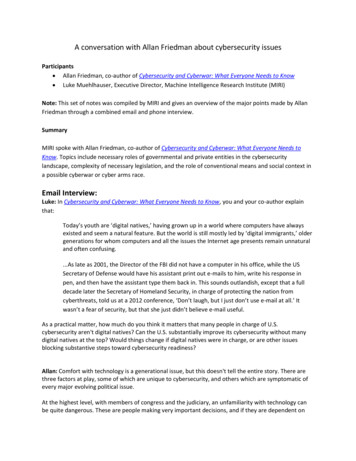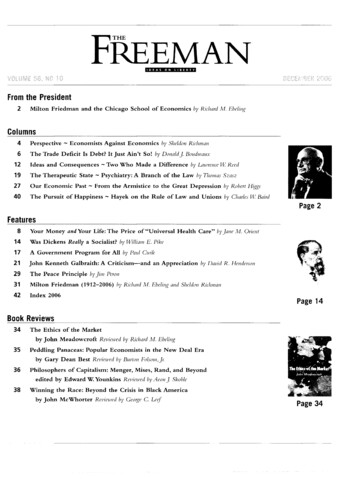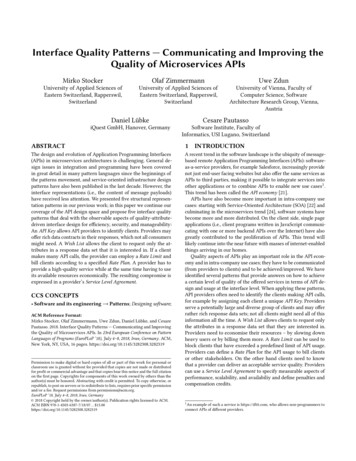
Transcription
A conversation with Allan Friedman about cybersecurity issuesParticipants Allan Friedman, co-author of Cybersecurity and Cyberwar: What Everyone Needs to Know Luke Muehlhauser, Executive Director, Machine Intelligence Research Institute (MIRI)Note: This set of notes was compiled by MIRI and gives an overview of the major points made by AllanFriedman through a combined email and phone interview.SummaryMIRI spoke with Allan Friedman, co-author of Cybersecurity and Cyberwar: What Everyone Needs toKnow. Topics include necessary roles of governmental and private entities in the cybersecuritylandscape, complexity of necessary legislation, and the role of conventional means and social context ina possible cyberwar or cyber arms race.Email Interview:Luke: In Cybersecurity and Cyberwar: What Everyone Needs to Know, you and your co-author explainthat:Today’s youth are ‘digital natives,’ having grown up in a world where computers have alwaysexisted and seem a natural feature. But the world is still mostly led by ‘digital immigrants,’ oldergenerations for whom computers and all the issues the Internet age presents remain unnaturaland often confusing.As late as 2001, the Director of the FBI did not have a computer in his office, while the USSecretary of Defense would have his assistant print out e-mails to him, write his response inpen, and then have the assistant type them back in. This sounds outlandish, except that a fulldecade later the Secretary of Homeland Security, in charge of protecting the nation fromcyberthreats, told us at a 2012 conference, ‘Don’t laugh, but I just don’t use e-mail at all.’ Itwasn’t a fear of security, but that she just didn’t believe e-mail useful.As a practical matter, how much do you think it matters that many people in charge of U.S.cybersecurity aren't digital natives? Can the U.S. substantially improve its cybersecurity without manydigital natives at the top? Would things change if digital natives were in charge, or are other issuesblocking substantive steps toward cybersecurity readiness?Allan: Comfort with technology is a generational issue, but this doesn't tell the entire story. There arethree factors at play, some of which are unique to cybersecurity, and others which are symptomatic ofevery major evolving political issue.At the highest level, with members of congress and the judiciary, an unfamiliarity with technology canbe quite dangerous. These are people making very important decisions, and if they are dependent on
their aides and clerks to explain things in metaphor, it can lead to misguided and dangerous policy.Young staffers may be digital natives, but that doesn't necessarily mean they are cyber experts. Thefamous Ted Stevens quote we cite in our book, when the octogenarian Senator explained that theInternet was a "series of tubes," reflects this. You can understand how a staffer tried to explain Internetcongestion to him, and he clearly didn't quite get it.At the same time, much of our national leadership has evolved and learned a great deal. In the Pentagonand in the Executive branch, we've seen a reorientation around how to approach the challenges weface, coming to understand the problem in a more nuanced and detailed fashion. Department ofHomeland Security leadership, for example, has grown to both recognize the importance ofcybersecurity and the complexities in dealing with the technical and economic issues involved. We'veramped up dozens of new programs and initiatives, led by people who wouldn't count as "digitalnatives,” but definitely appreciate specific challenges, and have the experience needed to driveprogress.The final question is one of the necessary shared expertise required for effective society-wide cyberresilience. How do the pundits talking about tensions in Eastern Europe incorporate cyber risk into theiranalyses? How do we help middle managers understand cyber risks, and how that relates to their dailyjobs? A cyber workforce isn't just the much-needed technical expertise to provide frontline networkdefenses. It requires integrating a basic understanding of digital risks into everything from the future ofsmart energy to the evolving relationship between government and the private sector. This may notrequire true digital natives, but it requires an understanding of what is at stake.Luke: At another point in the book, you write:“As we write, there are some fifty cybersecurity bills under consideration in the US Congress, yetthe issue is perceived as too complex to matter in the end to voters, and as a result, the electedrepresentatives who will decide the issues on their behalf. This is one of the reasons that despiteall these bills no substantive cybersecurity legislation was passed between 2002 and the writingof this book over a decade later.”Has any "substantive cybersecurity legislation" passed since you wrote the book? What kinds ofcybersecurity legislation do you think are most urgently needed at this point?Allan: The challenge of serious long-term cybersecurity legislation has always been the mismatch in pacebetween cybersecurity threats and potential legal solutions. It's not just the commonly understood storyof ever-present technical innovation, but also the evolving nature of the threat. The risks faced even fiveyears ago are different than those we face today.In the book, we talk about the need for information sharing, but also explain that it's not a simpleproblem that a basic law can promote: different types of information sharing pose different benefits andrisks.There are a number of questions in cybersecurity that must be addressed by the government becausethey are about explicit tradeoffs: how we balance risk. Some of these questions are quite delicate, withvery context-dependent details: what are the public and private responsibilities for securing information
infrastructures, or how accountable are publicly traded companies to their shareholders for investing insecurity and disclosing breaches? These are currently being addressed by various executive agencies,such as the voluntary National Institute of Standards and Technology (NIST) Framework, and theSecurity and Exchange Commission's voluntary guidelines. If these are found to be insufficient, thencongress may have to step in to endow regulatory agencies with more power (in the form of eitherrewards or punishments) to drive investment and accountability.Other political questions of balance are about the relative responsibilities of different areas ofgovernment. How will we balance the national security community's need to maintain offensive cybercapacity with their mission to defend this country and the rest of the defense establishment's networksand secrets? Do we need regulatory agencies such as the Federal Trade Commission to safeguardconsumers?Finally, the government may have to weigh in private sector questions to help align incentives towardsgreater security. Are consumer protection laws and state data breach notification laws enough? Whoshould bear the costs of credit card fraud, and the costs to prevent it? As we learn more about designingbetter, more secure systems, and as those systems become more integrated into our lives, will we needsome sort of liability to encourage better design? These questions can involve picking winners and losersin the private market, and will be very bitterly fought over.Notes from phone conversation on May 9th:Inherent tension between technology and riskWhether dealing with privacy or intellectual property, cybersecurity issues outpace legislation. This isnothing new: innovation happens faster than society and law can catch up. There is an inherent tensionbetween technology and risk. Technological advances have lead to huge gains in productivity, as well ashigh concentrations of risk through cloud computing, dependence on technical standards,interoperability, and more. It is important for the public to better understand the value of the rewardsvs. the risks as they both increase, and to incentivize good security practices. Adam Thierer argues inPermissionless Innovation that applying the precautionary principle to technology greatly inhibitsinnovation: seeking lower risk is a trade-off.It isn’t possible to expect perfect security, but the public should be able to expect a certain level ofsecurity. If a company fails to meet that standard, than a deterrent or punishment may be necessary, tobetter align the risks between the manufacturers, venders, and users. For example, Google’s Androidphone platform is developed by Google, but the operating system is ported to devices by handsetmanufacturers. In America, the consumer has a relationship with the carrier, who is unable to patch adevice, as they neither made the code nor ported it. At present no-one is held accountable for ensuringconsumers are protected, and all the risk falls on the consumer.An expanded role of government in cybersecurityMonitoring and law enforcement
The Federal Trade Commission has led the way in going after large and small companies that it believeshave misled their users in terms of security or privacy. The method of finding and punishing flagrantviolators may cause companies to pay attention more quickly than in other, more regulated industriessuch as energy or health care.Providing resources and support for ad-hoc, dynamic organizational forumsThe legal and economic needs and demands for information sharing are wildly different for differentcircumstances, and require a flexible approach. For example, if a company is able to detect fraudpatterns in users, but it has promised privacy for its users, how does it work with law enforcement? Thegovernment needs to support forums that bring together the relevant people with concerns over theseissues. This is true for a variety of concerns, from IPv6 conversion or DNS security to the internetgovernance question.Promoting and motivating responses to serious cybersecurity issues from the cybersecuritycommunityThere will be incidents where serious expertise on the national security front is critical, but the privatesector is likely to supply much of that expertise.In situations of compromised cybersecurity there are very real trade-offs between mitigating risk,restoring functionality, and gathering intelligence to pursue law enforcement and understand the depthof the threat. The importance of understanding the nature of an attack and innovating a solution to endit may eclipse the importance of incarcerating individual attackers.How the cyber community deals with new cybersecurity risksThe cybersecurity community often deals with new, unprecedented risks in a serendipitous,decentralized way, without the government playing an explicit role. Affected entities quickly organize,take responsibility, and respond, often with strong financial incentives. For example: The recent Heart Bleed bug was a massive interconnected risk, and the establishedinfrastructure organized quickly in response.The Conficker bug required software vendors, network vendors and internet software writers toquickly coordinate, address, and shut down the vulnerability.How should the cyber community deal with new cybersecurity violations?A very important question is how much we should expect privately held actors to defend what iseffectively a public infrastructure. We have learned that when a company reacts quickly and in isolation,this can often shape international policy — for example, when Google reacted to what it consideredespionage by withdrawing from China in 2010.Another approach is ‘hack back,” in which a private actor to respond to attacks without waiting forgovernment process or assistance. Hack back can be seen in two forms:
A weak form of hack back is to engage in actively gathering threat intelligence. This allows aprivate entity to better understand the attack and re-think future defenses and reaction.A strong form of hack back is to actively ‘punish’ the attacker, with aggressive, offensivebehavior. This is extremely dangerous, and could have unintended consequences.Importance of conventional warfare issues in the context of cyberwafareThe public often views cyberwar with a focus on the word ‘cyber’ but ignoring the context of the word‘war’. The United States has a stated policy reserving the right to respond to a cyber-attack withconventional means. Our conventional military complex is more accurate and reliable than our offensivecyber capabilities, so it makes sense to respond to a threat by these means. This may seem dangerousand rash, but a military response to a cyber-attack would be made in the same global context as anyother response to an attack on our national defense. Retaliation for cyber-attacks will be incrediblycontext-dependent and necessitates information on what country is responsible for the attack and why.A challenge here is the ‘attribution problem,’ where a government can’t decipher the origin of an attack.While this is a real possibility, the attack would have to maintain perfect operational security as well assecure execution, and conventional intelligence gathering would still be an effective tool incompromising operational security.Special fear of a cyber-attack may in part result from the psychological ‘conjunction fallacy’, where‘China is likely to launch a cyber-attack’, is presumed to be more likely than ‘China is likely to launch anattack’.Important factors in a possible ‘cyber arms race’ It is often assumed with new capabilities that offense is superior to defense. Historically, that isnot necessarily true, and may not be true in a future cyber arms race. Real people will be the principle vulnerabilities, so conventional intelligence will play a crucialrole. Compromising a single individual with proper access would be incredibly valuable andprobably much cheaper than a rigorous and tested offensive capacity. It Is relatively easy to hack a single computer, but knowing which exact computer to hack is anintelligence question. The cyber arms race will focus on intelligence and counter-intelligence,but now including digital networks, rather than simply human networks. Countries’ military establishments always compete to have the best technology, butcybersecurity is unique because a third party, the private sector, is independently deciding howto structure and secure itself.The importance of a public understanding of cybersecurityUnderstanding how to reduce cyber risk
Peter W. Singer comments that attacks have happened from picking up a CD or a flash drive from aparking lot or a men’s room floor. It is important for the public to understand and advocate for basic,good risk behavior and take cybersecurity seriously.Correcting fear of technologyMore broadly, a basic cybersecurity education will correct against an inflated public fear of the risks ofmodern technology: the idea that a person could turn off the power grid with a single key stroke, forexample. It is important for the public to understand how difficult this would be, and that manyproposed solutions to this kind of security threat will not dramatically mitigate that risk withoutimposing serious and substantial costs.Cybersecurity is not purely hype, however. It is a real problem that will not fix itself. It is a nuanced taskwithout a single holistic solution, but rather many incremental solutions. The government will have tofind its place in the solution, sometimes through new national laws, top-down international efforts, orthrough governmental agencies and oversight.All MIRI conversations are available at http://intelligence.org/category/conversations/
MIRI spoke with Allan Friedman, co-author of Cybersecurity and Cyberwar: What Everyone Needs to Know. Topics include necessary roles of governmental and private entities in the cybersecurity landscape, complexity of necessary legislation, and the role of conventional means and social context in a possible cyberwar or cyber arms race.










